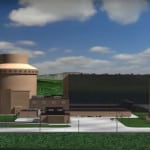Another year has passed and the promised U.S. nuclear renaissance is still in the Dark Ages. Blame for slow progress is usually cast on the pedestrian pace of finalizing loan guarantees, the economy and slow load growth, or the rising cost of construction. The excuses end when competition increases.
Two years have elapsed since the Department of Energy (DOE) solicited loan guarantee applications for new nuclear projects, yet the first contract remains unsigned. Ten complete applications were received, with an aggregate value of $188 million—about 10 times what the DOE has in its coffers for the program ($18.5 billion). There is also a production tax credit incentive of 2.1¢/kWh for the first 6,000 MW of new nuclear capacity in the first eight years of its operation (the same as is provided wind generators).
In February of this year, the DOE promised $8.33 billion for two new units at Plant Vogtle, owned by Southern Company, leaving about $10 billion on the table. Vying for the remaining loan guarantees are NRG Energy’s South Texas 3 and 4 near Houston; UniStar’s Calvert Cliffs 3 near Washington, D.C.; and Scana’s Virgil C. Summer 3 and 4 near Columbia, S.C. Preconstruction work is under way at the Summer and Vogtle sites.
For the sake of argument, let’s assume that the pending Nuclear Regulatory Commission (NRC) certifications go as planned and all four of these plants are completed over the next six or seven years. For perspective, 60 reactors are under construction worldwide, and all of those will be completed during this same time period. Chances are that construction will begin on another like-sized group of reactors in that same span of years, mostly in countries like Vietnam, India, South Korea, and Russia.
China Corp.
Nuclear work is moving at the speed of light in China, which has 24 plants under construction and more about to begin construction. During the same six- or seven-year period that the U.S. hopes to commission three or four plants, expect China to:
- Perfect its 1,080-MW CPR-1000 reactor (a Generation II+ reactor derived from the French three-loop design but with dozens of design improvements) with 90% or more of the reactor’s parts coming from Chinese suppliers. China is also close to becoming completely self-sufficient in the production of reactor parts, construction, and the remainder of the fuel cycle. (See p. 8.)
- Improve design and construction efficiencies to drive down the cost of new plants. The four-unit Ningde nuclear power plant began construction in February 2008. The first unit is slated for start-up in 2012 and the last in 2016. The entire cost of the four-unit plant is only $7.6 billion, or a paltry $1,760/kW.
- Shorten the construction lead time for new plants. The CPR-1000 project at Fangjiashan in Zhejiang province recently reached a milestone: The dome of Unit 1’s reactor was lifted into place just 21 months after construction started. The time to build China’s first 10 units was an average of 6.3 years; the current crop of plants is expected to take under five years. Expect the construction schedules to be further optimized to under four years in the near future, which would be competitive with the last ABWRs built in Japan.
- Become a world leader in Generation III reactors. China will have constructed 22 reactors in the five years ending in 2010. Of those reactors, only four are Westinghouse AP1000s and two are AREVA EPRs, all Generation III reactors. China’s agreement for purchase of these four AP1000 reactors includes major technology transfer. In fact, the head of the China Atomic Energy Authority has said that the designs derived from the AP1000 will be built after 2016, once experience is gained from the first four reactors.
Money to Invest
China Daily reported in September that the China National Nuclear Corp. (CNNC) expects to invest $120 billion in nuclear plant construction through 2020. CNNC also expects to begin seeking strategic investors (CNNC with at least 50% ownership) in local and foreign nuclear projects next year. In my opinion, that last statement is sending the U.S. a message.
The CPR-1000 licensing agreement with AREVA limits overseas sales, but the Chinese are working with Westinghouse to upsize the AP1000 (a Generation III reactor) to larger 1,400-MW (CAP1400) and 1,700-MW (CAP1700) designs, but with China owning the intellectual property rights. Construction is scheduled to start in 2013 on the first CAP1400, with operation planned in 2017. Potentially, NRC certification of these new designs is possible during the four or five years the prototype is under construction. I suspect those approvals could come much faster than for a brand new design, much as for the AP1000, which was a scale-up of the AP600 design.
What happens when CNNC elects to enter the U.S. market in 2017 with then-proven designs at an installed cost significantly below that of the current crop of reactors? Should China send a clear signal to the U.S. market of its intentions, it would cause every nuclear utility CEO to press the pause button on their nuclear ambitions.
After all, who wants to buy today at retail when the “Made in China” big box nuclear store may be opening soon.
— Dr. Robert Peltier, PE, is POWER’s editor-in-chief.










